#chordate notes
Explore tagged Tumblr posts
Text
Who needs proper ADHD meds when you have CAFFEINE

My sweet, sweet, elixer of focus
2 notes
·
View notes
Note
why did you tag that horse video with #chordate? the organizational system that implies fascinates me

3K notes
·
View notes
Text
I haven't posted in a while because I've been busy with some big commissions but here's a low-quality little guy I made as a secondary element of one of said commissions (generalized conodont):
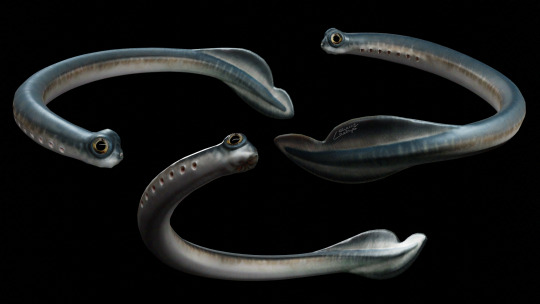
References and notes:
Following the "standard" for conodont reconstructions, morphology is based on the 3 species with known soft tissues (Clydagnathus windsorensis, Panderodus unicostatus, and the giant Promissum pulchrum) (Aldridge et al. 1986, Gabbott et al. 1995, Murdock & Smith 2021), with details filled in from living hagfish and lampreys based on the assumed vertebrate (and possibly even cyclostome) affinity of conodonts (Miyashita et al. 2019). The count of 7 pairs of gill openings (as in lampreys) is simply because i couldn't be bothered to sculpt more.
Note that the mouth is not depicted as a the usual gaping hole filled with spiny elements but rather as folded tissues nicely hiding any trace of offensive toothiness, much like modern hagfish, which, despite their impressive set of "teeth", have a very kissable (closed) mouth. I understand the didactic value of showing the element apparatus in conodont reconstructions but have always felt a little weird about depicting animals actually swimming around looking like that... but who knows?
Another departure from the usual way of reconstructing conodonts is the inclusion of a single nostril. This is based on the single nostril of extant hagfish and lamprey (to which (eu-)conodonts may be most closely related to) (Miyashita et al. 2019), and also supported by the fact that a single nostril may be part of the ancestral state of vertebrates (Oisi et al. 2013) (assuming conodonts are actually vertebrates, of course).
Anyway, that was a lot of reading and shoddy speculation for a background model. Certainly don't trust any of it, I don't know shit about conodonts.
References:
Aldridge, R. J., Briggs, D. E. G., Clarkson, E. N. K., & Smith, M. P. (1986). The affinities of conodonts—New evidence from the Carboniferous of Edinburgh, Scotland. Lethaia, 19(4), 279–291. https://doi.org/10.1111/j.1502-3931.1986.tb00741.x
Gabbott, S. E., Aldridge, R. J., & Theron, J. N. (1995). A giant conodont with preserved muscle tissue from the Upper Ordovician of South Africa. Nature, 374(6525), 800–803. https://doi.org/10.1038/374800a0
Miyashita, T., Coates, M. I., Farrar, R., Larson, P., Manning, P. L., Wogelius, R. A., Edwards, N. P., Anné, J., Bergmann, U., Palmer, A. R., & Currie, P. J. (2019). Hagfish from the Cretaceous Tethys Sea and a reconciliation of the morphological–molecular conflict in early vertebrate phylogeny. Proceedings of the National Academy of Sciences of the United States of America, 116(6), 2146–2151. https://doi.org/10.1073/pnas.1814794116
Murdock, D. J. E., & Smith, M. P. (2021). Panderodus from the Waukesha Lagerstätte of Wisconsin, USA: A primitive macrophagous vertebrate predator. Papers in Palaeontology, 7(4), 1977–1993. https://doi.org/10.1002/spp2.1389
Oisi, Y., Ota, K. G., Kuraku, S., Fujimoto, S., & Kuratani, S. (2013). Craniofacial development of hagfishes and the evolution of vertebrates. Nature, 493(7431), 175–180. https://doi.org/10.1038/nature11794
#dubious speculation#<- i'll be using that tag in the future for reconstructions involving disputable or unsupported personal takes (see notes under the cut)#also no fine attention given to anatomy and proportions for this one#probably don't use it as a reference for anything#conodont#chordate#paleozoic#paleontology#paleoart#palaeoblr#my art
30 notes
·
View notes
Text
Peale's Dolphin Classification
Kingdom = Animalia
Phylum = Chordata
Class = Mammalia
Order = Artiodactyla
Infraorder = Cetacea
Family = Delphinidae
Genus = Lagenorhynchus
Species = L. australis
.
Patreon
#studyblr#notes#biology#bio#bio notes#biology notes#marine science#marine biology#marine science notes#marine sci notes#marine biology notes#marine bio#marine bio notes#science#life science#animals#animal science#chordates#dolphins#taxonomy#classification#life classification
4 notes
·
View notes
Text
I recently found out a show I liked is 10 years old now so to not be the oldest thing on this blog I'm talking coelacanths for Wet Beast Wednesday. Coelacanths are rare fish famed for being living fossils. While that term is highly misleading, it is true that coelacanths are among the only remaining lobe-fined fish and were thought to have gone extinct millions of years ago before being rediscovered in modern times.
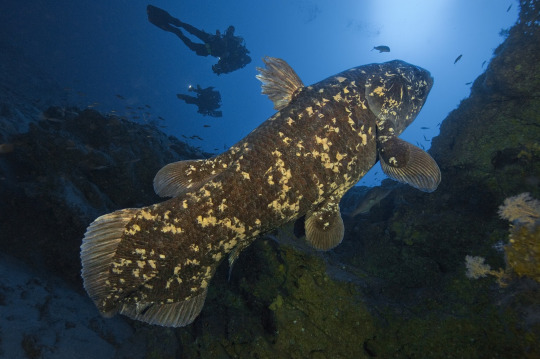
(image id: a wild coelacanth. It is a large, mostly grey fish with splotches of yellowish scales. Its fins are attached to fleshy lobes. It is seen from the side, facing the top right corner of the picture)
Coelacanth fossils had been known since the 1800s and they were believed to have gone extinct in the late Cretaceous period. That was until December 1938, when a museum curator named Marjorie Courtenay-Latimer was informed of an unusual specimen that had been pulled in by local fishermen. After being unable to identify the fish, she contacted a friend, ichthyologist J. L. B. Smith, who told her to preserve the specimen until he could examine it. Upon examining it early next year, he realized it was indeed a coelacanth, confirming that they had survived, undetected, for 66 million years. Note that fishermen living in coelacanth territory were already aware of the fish before they were formally described by science. Coelacanths are among the most famous examples of a lazarus taxon. This term, in the context of ecology and conservation, means a species or population that is believed to have gone extinct but is later discovered to still be alive. While coelacanths are among the oldest living lazarus taxa, they aren't the oldest. They are beaten out by a genus of fly (100 million years old) and a type of mollusk (over 300 million years old).

(image: a coelacanth fossil. It is a dark brown imprint of a coelacanth on white rock. Its skeleton is visible in the imprint)
Coelacanths are one of only two surviving groups of lobe-finned fish along with the lungfishes. Lobe-finned fish are bony fish notable for their fins being attached to muscular lobes. By contrast, ray-finned fish (AKA pretty much every fish you've ever heard of that isn't a shark) have their fins attached directly to the body. That may not sound like a big difference, but it actually is. The lobes of lobe-finned fish eventually evolved into the first vertebrate limbs. That makes lobe-finned fish the ancestors of all reptiles, amphibians, and mammals, including you. In fact, you are more closely related to a coelacanth than a coelacanth is to a tuna. Coelacanths were thought to be the closest living link to tetrapods, but genetic testing has shown that lungfish are actually closer to the ancestor of tetrapods.
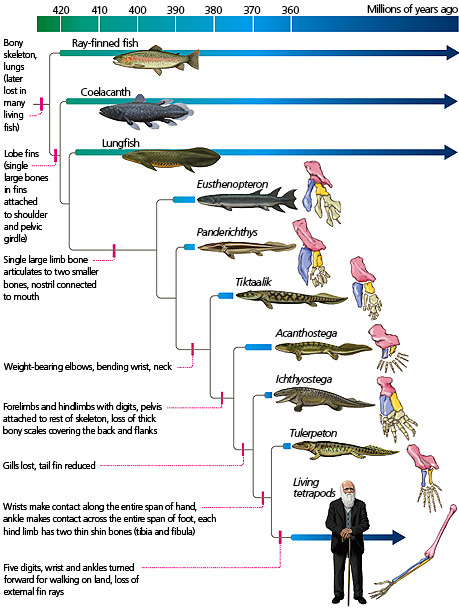
(image id: a scientific diagram depicting the taxonomic relationships of early lobe-finned fish showing their evolution to proto-tetrapods like Tiktaalik and Ichthyostega, to true tetrapods. Source)
There are two known living coelacanth species: the west Indian ocean coelacanth (Latimeria chalumnae) and the Indonesian coelacanth (L. menadoensis). Both are very large fish, capable of exceeding 2 m (6.6 ft) in length and 90 kg (200 lbs). Their wikipedia page describes them as "plump", which seems a little judgmental to me. Their tails are unique, consisting of two lobes above and below the end of the tail, which has its own fin. Their scales are very hard and thick, acting like armor. The mouth is small, but a hinge in its skull, not found in any other animal, allows the mouth to open extremely wide for its size. In addition, they lack a maxilla (upper jawbone), instead using specialized tissue in its place. They lack backbones, instead having an oil-filled notochord that serve the same function. The presence of a notochord is the key characteristic of being a chordate, but most vertebrates only have one in embryo, after which it is replaced by a backbone. Instead of a swim bladder, coelacanths have a vestigial lung filled with fatty tissue that serves the same purpose. In addition to the lung, another fatty organ also helps control buoyancy. The fatty organ is large enough that it forced the kidneys to move backwards and fuse into one organ. Coelacanths have tiny brains. Only about 15% of the skull cavity is filled by the brain, the rest is filled with fat.
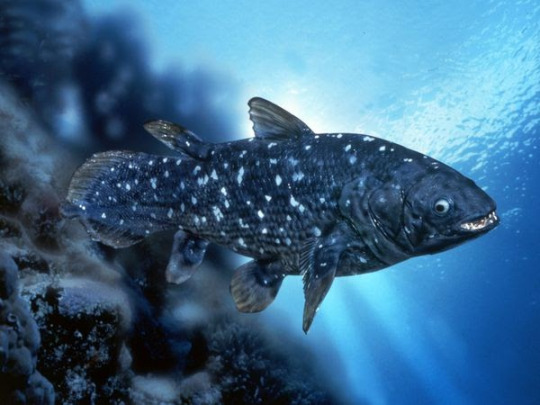
(image id: a coalacanth. It is similar to the one on the above image, but this one is blue in color and the head is seen more clearly, showing an open mouth and large eye)
One of the reasons it took so long for coelacanths to be rediscovered is their habitat. They prefer to live in deeper waters in the twilight zone, between 150 and 250 meters deep. They are also nocturnal and spend the day either in underwater caves or swimming down into deeper water. They typically stay in deeper water or caves during the day as colder water keeps their metabolism low and conserves energy. While they do not appear to be social animals, coelacanths are tolerant of each other's presence and the caves they stay in may be packed to the brim during the day. Coelacanths are all about conserving energy even when looking for food. They are drift feeders, moving slowly with the currents and eating whatever they come across. Their diet primarily consists of fish and squid. Not much is known about how they catch their prey, but they are capable of rapid bursts of speed that may be used to catch prey and is definitely used to escape predators. They are believed to be capable of electroreception, which is likely used to locate prey and avoid obstacles. Coelacanths swim differently than other fish. They use their lobe fins like limbs to stabilize their movements as they drift. This means that while coelacanths are slow, they are very maneuverable. Some have even been seen swimming upside-down or with their heads pointed down.
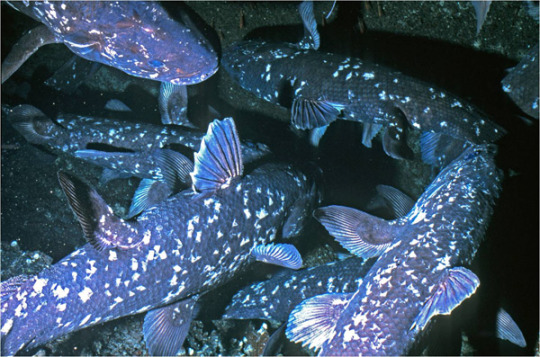
(image: an underwater cave wilt multiple coelacanths residing in it. 5 are clearly visible, with the fins of others showing from offscreen)
Coelacanths are a vary race example of bony fish that give live birth. They are ovoviviparous, meaning the egg is retained and hatches inside the mother. Gestation can take between 2 and 5 years (estimates differ) and multiple offspring are born at a time. It is possible that females may only mate with a single male at a time, though this is not confirmed. Coelacanths can live over 100 years and do not reach full maturity until age 55. This very slow reproduction and maturation rate likely contributes to the rarity of the fish.
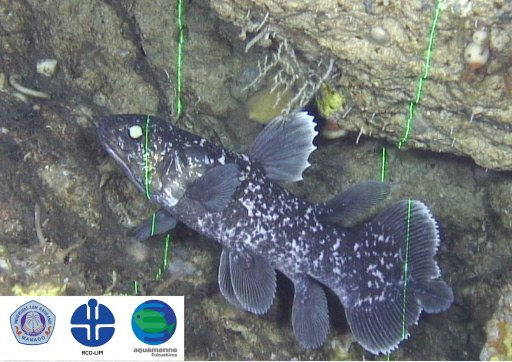
(image: a juvenile coelacanth. Its body shape is the same as those of adults, but with proportionately larger fins. There are green laser beams shining on it. These are used by submersibles to calculate the size of animals and objects)
Coelacanths are often described as living fossils. This term refers to species that are still similar to their ancient ancestors. The term is losing favor amongst biologists due to how misleading it can be. The term os often understood to mean that modern species are exactly the same as ancient ones. This is not the case. Living coelacanth are now known to be different than those who existed during the Cretaceous, let alone the older fossil species. Living fossils often live in very stable environments that result in low selective pressure, but they are still evolving, just slower.
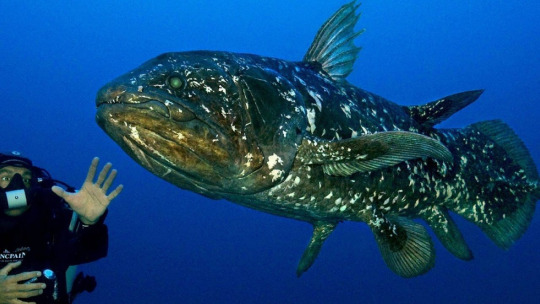
(image: a coelacanth swimming next to a SCUBA diver)
Because of the rarity of coelacanths, it's hard to figure out what conservation needs they have. The IUCN currently classifies the west Indian ocean coelacanth as critically endangered (with an estimated population of less than 500) and the Indonesian coelacanth as vulnerable. Their main threat is bycatch, when they are caught in nets intended for other species. They aren't fished commercially as their meat is very unappetizing, but getting caught in nets is still very dangerous and their slow reproduction and maturation means that it is long and difficult to replace population losses. There is an international organization, the Coelacanth Conservation Council, dedicated to coelacanth conservation and preservation.
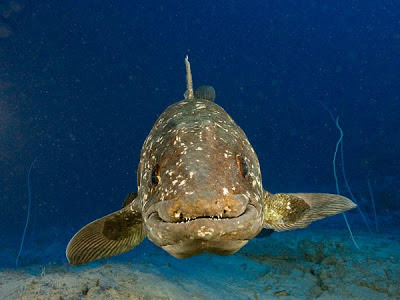
(image: a coelacanth facing the camera. The shape of its mouth makes it look as though it is smiling)
#wet beast wednesday#coelacanth#marine biology#biology#zoology#ecology#animal facts#fish#fishblr#old man fish#lobe-finned fish#sarcopterygii
1K notes
·
View notes
Note
Birds are class Aves.
Sure, under Linnaean taxonomy. But, well,
A) Linnaeus was a eugenecist so his scientific opinions are suspect and his morality is awful
B) he didn't know about evolution
C) he didn't know about prehistoric life
so his classification system? Sucks ass. It doesn't work anymore. It no longer reflects the diversity of life.
Instead, scientists - almost across the board, now - use Clades, or evolutionary relationships. No rankings, no hierarchies, just clades. It allows us to properly place prehistoric life, it removes our reliance on traits (which are almost always arbitrary) in classifying organisms, and allows us to communicate the history of life just by talking about their relationships.
So, for your own edification, here's the full classification of birds as we currently know it, from biggest to smallest:
Biota/Earth-Based Life
Archaeans
Proteoarchaeota
Asgardians (Eukaryomorphans)
Eukaryota (note: Proteobacteria were added to an asgardian Eukaryote to form mitochondria)
Amorphea
Obazoa
Opisthokonts
Holozoa
Filozoa
Choanozoa
Metazoa (Animals)
ParaHoxozoa (Hox genes show up)
Planulozoa
Bilateria (all bilateran animals)
Nephrozoa
Deuterostomia (Deuterostomes)
Chordata (Chordates)
Olfactores
Vertebrata (Vertebrates)
Gnathostomata (Jawed Vertebrates)
Eugnathostomata
Osteichthyes (Bony Vertebrates)
Sarcopterygii (Lobe-Finned Fish)
Rhipidistia
Tetrapodomorpha
Eotetrapodiformes
Elpistostegalia
Stegocephalia
Tetrapoda (Tetrapods)
Reptiliomorpha
Amniota (animals that lay amniotic eggs, or evolved from ones that did)
Sauropsida/Reptilia (reptiles sensu lato)
Eureptilia
Diapsida
Neodiapsida
Sauria (reptiles sensu stricto)
Archelosauria
Archosauromorpha
Crocopoda
Archosauriformes
Eucrocopoda
Crurotarsi
Archosauria
Avemetatarsalia (Bird-line Archosaurs, birds sensu lato)
Ornithodira (Appearance of feathers, warm bloodedness)
Dinosauromorpha
Dinosauriformes
Dracohors
Dinosauria (fully upright posture; All Dinosaurs)
Saurischia (bird like bones & lungs)
Eusaurischia
Theropoda (permanently bipedal group)
Neotheropoda
Averostra
Tetanurae
Orionides
Avetheropoda
Coelurosauria
Tyrannoraptora
Maniraptoromorpha
Neocoelurosauria
Maniraptoriformes (feathered wings on arms)
Maniraptora
Pennaraptora
Paraves (fully sized winges, probable flighted ancestor)
Avialae
Avebrevicauda
Pygostylia (bird tails)
Ornithothoraces
Euornithes (wing configuration like modern birds)
Ornithuromorpha
Ornithurae
Neornithes (modern birds, with fully modern bird beaks)
idk if this was a gotcha, trying to be helpful, or genuine confusion, but here you go.
all of this, ftr, is on wikipedia, and you could have looked it up yourself.
671 notes
·
View notes
Text

Greetings, chordate comrades.
#InverteFest is officially here. We invite you to nerd out about invertebrates for an entire week on whichever social platform you're on. Feel free to reupload this image to spread the word!
Can't find critters in the wild?
Show us: - Your pet snail - Your Vivillon collection - That scifi book about sentient clams - Your OC based on a parasitic nematode - That game where you played as a crab with a sword
Feel free to come up with your own idea, we don't gatekeep fun!
Want to contribute to community science?
If you have an iNaturalist account, you could contribute by surveying your local critters! Join the project using this link.
Note that only photos taken between 24-30 April your LOCAL time will be counted!
The time frame and project URL will vary each season, but I plan on reblogging this post each season and updating the dates and links.
For the full explanation in screen reader-friendly format, go to invertefest.com
658 notes
·
View notes
Text
If you think there are at least some non-animal organisms, like archaea or fungi or all opisthokonts plants, that meet the stated criteria, select the first option ("Animals or other.") We're discussing terrestrial, biological life only, though, so extraterrestrial life, supernatural beings, or machine intelligences do not figure in to this scheme (but feel free to discuss them in the notes).
Eumetazoa is, AFAICT, the largest group of animals that includes all animals with at least some nervous tissue--so not sea sponges. But it does include a few clades without nervous systems, like the Placozoa.
Chordates are all animals containing a dorsal nerve cord specifically: chordates do not include, e.g., insects, molluscs (including octopuses and squid), and starfish. Chordates do include all fish.
Tetrapods include all animals with four limbs and distinct digits; this excludes most, but not all fish, and includes reptiles, mammals, dinosaurs (including birds), and amphibians.
Mammals includes all animals that nurse their young, have fur, have a neocortex, and have three middle ear bones. This group includes monotremes like the platypus, as well as more familiar animals like dogs, cats, cows, horses, mooses, and more(ses).
Primates includes monkeys, lemurs, apes, tarsiers, lorises and, of course, humans (though all of these clades include humans).
Hominids include gorillas, orangutans, chimpanzees, and humans ("apes").
Hominins includes just humans and chimpanzees (including bonobos). (I think; the taxonomic nomenclature distinguishes between Hominidae, Hominini, Homininae, Hominina, and Hominoidae, so I might have mixed some of these up. Blame the ICZN or whoever is responsible for this mess.)
Australopithecines (equivalent to "Hominina," I think, but don't quote me on that) includes all extinct hominins more closely related to humans than to any other extant species, like Australopithecus africanus, Paranthropus robustus, and of course later species like Neanderthals and Homo sapiens.
Homo is the genus that includes the whole human family in the broad sense: modern humans, Neanderthals, Denisovans, Homo erectus, and Homo habilis.
Homo sapiens includes only anatomically modern humans, as we emerged around 300,000 years ago in Africa.
#i really wanted like four or five more options#to make this poll with sufficient granularity#oh well#pretend eukaryotes bilateria vertebrates and placental mammals are also on the list#and possibly synapsids and the eukaryotes+archaea group just for fun
66 notes
·
View notes
Text

(Long ah post) Re-did my monster taxonomy again, now with more ranks and specificity. I shall now go into more detail about everything on there. Some taxons are grouped together for lack of anything differentiating them. Things in italics and parentheses are out of universe notes, everything else is information known to the monsters. Also yes this does mean the scientific names for the old monstiary pages are almost all inaccurate again.
Monsters are under the domain Monstra. To be put in the domain you need to be sapient and capable of breeding, some exceptions may be made for certain monsters that are clearly monsters but can’t breed. (The chart is nearly the same as the ones that are used in the modern day monster world, but the exact arrangements of species may be changed as some “monsters” aren’t even monsters but most don’t know that nor have a way to find out. Divina was added after the Wubbox were discovered, thus the addition of the last part of the previous in-world sentence as they can’t breed)
Kingdoms
(This was added after the original document was written) Divina is where the monster species made directly by gods go, a semi-waste bin taxa. The name “Divina” goes down to the genus allowing for unique species names. They seem to be immortal, and possess great power over their elements. The two monsters under the ranks are Divina mechana (Wubbox) and Divina simiservice (Enchantling). Organica contains the ordinary monsters made of living organic matter. They have living cells, can breed, and most of them need to eat, but that’s not a requirement. Inorganica contains the ordinary monsters that are made of primarily inorganic/non living matter while they are alive. They can breed, and none of them need to eat. They run entirely off of their lifeforce, but they eat sometimes for enjoyment.
Phylums
Beastia or beasts are critter-like monsters. Mondragora contains plant-like monsters (Mushrooms are plants in this universe, but there are true fungus like molds and yeasts, they just are barely researched). Reanimata or reanimated monsters are similar to the undead from ancient stories. These monsters are made of cells, but dead ones. Constructa are mainly made of non cellular materials.
Classes (not element classes those are different)
Segmenta or segmented monsters have an segmented exoskeleton composed of chitin, a nervous system primarily on their ventral side, hemolymph, a heart that is on the dorsal side, and molt to grow. Jellatina (through that to jellatidae) or jellatinous monsters are a very broad classification, a semi-wastebin taxon. Basically they don’t have a spinal cord, but aren’t segmented. Chordata or chordates have spines of some sort, even if they are very small and simple as in the inkfish(Atrapicidae). They have blood, and internal mineralized bones. Fungi (to Sporalis) or mushroom monsters have no leaves, are consumers, and aren’t like critters. They are actually a network of mycelium and what looks like their bodies are actually just puppets that are made for interacting with other monsters, and maybe aiding in breaking down food. They can shortly detach these and animate them for a bit while not connected to their mycelium, this behavior is most commonly seen in Sporalis sadisticus (Squot), but the others can do it too. Plantae (to Florales) or plant-like monsters are, well, plant-like monsters. They have chloroplasts and are autotrophs, and can absorb nutrients from soil through special membranes mostly on their feet, but some other monsters can do this too so it’s not a requirement. Instead of activating muscles with muscle fibers, they use hydraulics. They inject and retract water from special absorbent tissues that expand and shrink depending on how much water is in them. For transporting materials through their bodies they use xylem. Phantasma (to Phantidae) or phantoms are ghost-like monsters. They have no organs and instead use a special fluid called ectoplasm that does all their bodily functions like digestion, material transport, and movement. Speaking of movement ectoplasm can stay suspended mid air allowing them to float. Skelleosis (to Skelidae) or skeleton monsters are mostly made of calcified bones. They don’t need to eat, sleep, or do anything a living organism needs to do. Constructa(the class, to Mechina) are monsters that construct their bodies. They often start out by their egg morphing into their first form, and then as they gain more lifeforce as they grow they can support a larger body and add on to their forms. Incramentids (to Goleformes) are inorganic monsters that grow like an organic one rather than building themselves.
Orders
Arachnids ( to Vasucta) are segmented monsters that eat by liquifying their food with their digestive juices by injecting it into their food with fangs. Insectiformes are the segmented monsters that eat by chewing or sucking up already liquid food. Synapsids (to Mammalidae) have solid skulls with three holes in each side, differentiated teeth, warm blood, and are the only organic monsters that can have fur. Amphibians (to Amphibidae) are monsters with skin they can breathe through when wet, and solid skulls. Sauropids have solid skulls with five holes in them, and undifferentiated teeth. Piciformes or piscine monsters have skulls with multiple parts, undifferentiated teeth, and partial thermal regulation. Most have gills and lungs.
Families
Crustacean (to Crustata) monsters are Insectoid monsters that have filamentous gills that they use to breathe. Insect monsters are Insectoid monsters that breathe through spiracles. Reptilidae or reptilian monsters are cold blooded and are primarily covered in scales. Avidae or avian monsters are warm blooded sauropsids. Ossipicidae or ossipicids are piscine monsters with calcified bones. Cartelpicidae or cartelpicids are piscine monsters with cartilage bones. Atrapicidae (to Suctipedes) or inkfish are piscine monsters with beaks, very underdeveloped spines that are one or two bones. Herboceae or herbal monsters are plant-like monsters with no bark on them and instead have soft stems. Arboraceae or tree monsters are monsters with bark. Miniralidae (to Geologica) are monsters made of minerals, they typically eat the minerals that they are made of and they are then heated in a special organ called a kiln, the molten rock is then gradually pushed to the surface to cool and harden into the new surface plates of rock. How they move has been theorized to be magic based. Articinidae (to Artinzina)or artisan monsters are made of materials like wood, fabric, or other crafts materials. They grow and do everything in a magic based way.
Genuses
Insectidae - Dronsecta or dronesects are insect monsters that can open portals with their wings. Larvasa are neotonus insectoids that stay in their larval states for their entire lives. Colomu means colored wings and Colomu have colored wings instead of the clear ones other insectoids have. Insectidae is just a wastebin-taxon where the rest of the insect monsters go.
Jellatidae - Membrana have membranes around their fluid insides. Fluidum have part of their bodies as uncontained fluids, the only monster in this genus are Fluidum _____ (haven’t named the species yet) (Whimsies), wich boil the fluid to fill a sack they make to contain it, which allows them to float. Molluscus is a wastebin-taxon that contains the rest of the soft bodied monsters.
Mammalidae - Ferrae are carnivorous monsters that actively hunt things and have sharp teeth. Ruminanta are monsters that have more than 4 stomachs and eat grasses and other tough things that require a lot of digestion. Humammalia are bipedal omnivorous monsters with mostly flat teeth. Psudoreptillia are semi-cold blooded monsters with calcified skin that resemble scales. Thumpidae are monsters that share a morphological resemblance to or are Thumpidae thumpus (Thumpies), which means they have no ribs and primarily move with spring loaded bones retracted by muscles. Cabutoris exists to contain the species Cabutoris maw (Maws), which fit nowhere else.
Amphibidae - Anura have no tails, Squamosis have calcified lumps beneath their skin that make them look like they have scales.
Reptilidae - Lizardae have flat-tipped tongues. Dracoda have forked tongues. Dinodae have non-splayed-out limbs.
Avidae - Pluma have beaks and most are flighted. Humavia are bipedal and don’t have beaks, have bird-like feet, and no fur.
Ossipicedae - Squamifer have scales, Lenis don’t.
Cartelpicedae - Rayta have ray-like cartilage in their limbs, Serrata have serrated teeth which are mineralized.
Herboceae - Herbosa have proper leaves that are fairly thin, Suculata have thick leaves and store a lot of water.
Arboraceae - Ambularborae have no bark covered trunk, Trunka as the name implies, do
Phantidae - Banshee contains Banshee banshee (Whisps), and Banshee talona (Withurs). Felaspira contains Felaspira furrus (Ghatz) Felaspira serpenta (Xysters).
Skelidae - Carossis have some non-bone tissue, ossa are all bone.
28 notes
·
View notes
Text
130 Day Productivity Challenge!
9 Jan '24 - Day 18


I'm not sorry that when it rains, I make it my whole personality.
Today was a quick day and a slow day.
We studied Biotechnology Application, Haloalkanes and haloarenes and completed EMI.
I worked on my NCERT notes on Chordates and also solved the objective questions of EMI.
Hope you had a good day💛
3 notes
·
View notes
Text

I posted 19,598 times in 2022
That's 13,345 more posts than 2021!
118 posts created (1%)
19,480 posts reblogged (99%)
Blogs I reblogged the most:
@strawberry-crocodile
@catwaifuwu
@goldenvicious
@emotionalmilkshake
I tagged 1,672 of my posts in 2022
#ingo and emmet - 43 posts
#anthem posts - 30 posts
#morbposting - 26 posts
#walking with dinosaurs - 24 posts
#chased by dinosaurs liveblogging - 23 posts
#jerma moment - 23 posts
#submas - 21 posts
#dinovember - 13 posts
#transfem hunter - 12 posts
#dinovember 2022 - 12 posts
Longest Tag: 139 characters
#his name is asac shrader (its hank) aaaasac shraaadeeer (his name is hank) aaaasac shraaadeeer (its time for you to leave me) fuck yourself
My Top Posts in 2022:
#5
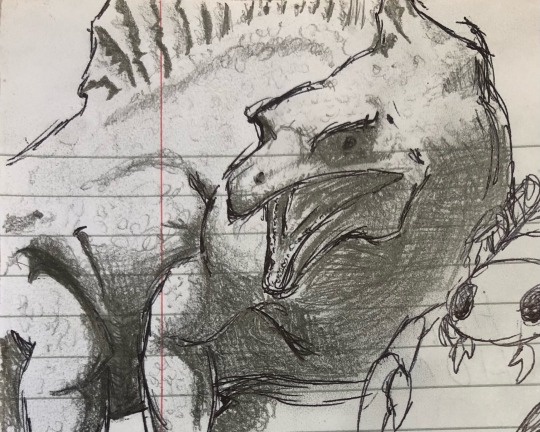
I can assure you this Edaphosaurus that I drew in the corner of my notebook is going to be 10 times better than anything I’ll do for Dinovember next month (ft. Pterygotus)
Also this is the first time I’ve posted art to tumblr for a while; as I’ve said, I’m going to be doing Dinovember next month so you’ll probably see more of my silly doodles in the future. Stay tuned!!
19 notes - Posted October 11, 2022
#4

DINOVEMBER DAY 1: 520MYA, STAGE 3 OF THE CAMBRIAN; YUNNAN, CHINA
It is the Cambrian period, and the warm sunlit seas of Southern China are home to a vibrant sponge-reef brimming with life. The creatures of the Cambrian are strange to us in the Holocene, as this period of time is a time of great experimentation in bodyplans thanks to the evolution of a very special type of organ: eyes. Predators can now see their prey, and vice versa, so the pace of life has sped up considerably, and everyone has had to adapt. Many organisms now have hard shells, spiny defences, or increased mobility to protect themselves from these new sighted predators.
One such predator is this Lyrarapax, cruising through a small group of Haikouichthys. You might be more familiar with her Canadian cousin Anomalocaris. At around half a metre long, Lyrarapax is one of the top predators of the Chengjiang biota; her strange arm like protrusion are derived from the filter feeding appendages of her ancestors, and she uses them to grab prey such as trilobites and pass them to the crushing wheel-like mouth on the underside of her head.
Arthropods like her dominate the Cambrian seas, and along with cephalopod molluscs, will rule the Ordovician as well. Primitive chordates like Haikouichthys will remain in their shadow… for now.
21 notes - Posted November 1, 2022
#3
Hawks can commit arson
23 notes - Posted May 26, 2022
#2
youtube
OH MY GOD GUYS????? NEW PREHISTORIC DOCUMENTARY FEATURING NIGEL MARVEN????
Seriously though, Agate looks to be an amazing project, with three 15 minute episodes taking us on a tour of Miocene Nebraska. It’s a crowdfunded project, so if you can spare the change, go and check out their kickstarter!
35 notes - Posted November 23, 2022
My #1 post of 2022
This person is trying to publish their paper on Daspletosaurini! I'm helping the only way I know how to.
41 notes - Posted May 19, 2022
Get your Tumblr 2022 Year in Review →
#tumblr2022#year in review#my 2022 tumblr year in review#your tumblr year in review#Youtube#woag.. ive been poasting#anthem posts
3 notes
·
View notes
Note
I know you hate mammal bias. So do I.
But I have a special interest in rabbits.
Could you give me the true classification details (like you did with the "birds are aves" ask) for European rabbit?
Or show me where to look?
Once again, I wouldn't ask, it's just rabbits are my world.
Thanks
Also I used to keep and breed budgies, had two Fischer's lovebirds too (separately as not a pair). Parrots are great!!!!
Hey, mammal bias just means focusing on or highlighting mammals disproportionately - acting like they're all of life, the majority of life, or the most important life forms, etc. Enjoying mammals is a totally normal and expected thing to do, and is totally fine. I personally love cetaceans, marsupials, and bats! A lot! (never going to get over the layers of irony in the Flying Poll Fiasco)
Anyways, here you go!
Biota/Earth-Based Life
Archaeans
Proteoarchaeota
Asgardians
Eukaryomorphans
Eukaryota (note: Proteobacteria were added to an Archaean to form mitochondria and modern day Eukaryotes)
Amorphea
Obazoa
Opisthokonts
Holozoa
Filozoa
Choanozoa
Metazoa (Animals)
Bilateria (all bilateran animals)
a huge mess at the base of animals that we aren't sure of bc apparently deuterostomy isn't monophyletic whoops
Chordata (Chordates)
Olfactores
Vertebrata (Vertebrates)
Gnathostomata (Jawed Vertebrates)
Eugnathostomata
Osteichthyes (Bony Vertebrates)
Sarcopterygii (Lobe-Finned Fish)
Rhipidistia
Tetrapodomorpha
Eotetrapodiformes
Elpistostegalia
Stegocephalia
Tetrapoda (Tetrapods)
Reptiliomorpha
Amniota (animals that lay amniotic eggs or evolved from those that did)
Synapsida (pan-mammalia)
Eupelycosauria
Sphenacodontia
Pantherapsida
Sphenacodontoidea
Therapsida
Theriodontia
Eutheriodontia
Cynodontia
Epicynodontia
Eucynodontia
Probainognathia
Prozostrodontia
Mammaliamorpha
Mammaliaformes
Crown-Mammalia
Theriimorpha
Theriiformes
Trechnotheria
Cladotheria
Prototribosphenida
Zatheria
Tribosphenida
Theria
Eutheria
Placentalia
Boreoeutheria
Euarchontoglires
Gliriformes
Glires
Duplicidentata
Lagomorpha
Leporidae
Oryctolagus
Oryctolagus cuniculus
Because we're going all the way down to a species, it's a bit longer than the list for all birds!
Fun fact, the list for humans is the same through and including Euarchontoglires!
83 notes
·
View notes
Text
Red Wolf Classification
Kingdom = Animalia
Phylum = Chordata
Class = Mammalia
Order = Carnivora
Family = Canidae
Genus = Canis
Species = C. rufus
Patreon | Ko-fi
#studyblr#notes#zoology#zoology notes#biology#biology notes#bio#bio notes#red wolf#red wolf classification#classification#taxonomy#taxonomy notes#classification notes#biological classification#species#carnivores#animals#chordates
3 notes
·
View notes
Text
Does anyone have any recommended apps/websites that would help me organize my evolution/comparative chordate anatomy notes?
I have a lot of information that needs to be written down and the way that my notes have been working out has been kind of confusing
2 notes
·
View notes
Photo

Evolution of Chordates
0 notes
Text
The Most Fundamental Identity
Like most artificial human categories, ‘animal’ is a grouping that gets a little fuzzy around the edges. You’ve got your really central examples- cows and lizards and birds and fish and such. Bugs, maybe a tiny bit less so, but they’re still basically animals. There’s that tier of things that are definitely animals but feel a little alien- clams, starfish, barnacles. And then there’s stuff like sea sponges where calling it an animal feels almost like a point of trivia, a technical definition that doesn’t really have much relevance to ‘animal’ as an active word in day to day life.
Everybody will have their own rankings here, and of course there’s no one right answer. As for me, I know there are a few things my instincts tend to weigh pretty heavily, like whether the organism has a visible head or face, whether it moves and shows agency, whether it’s symmetrical… stuff like that. These instincts tend to favor things closer to me on the evolutionary tree. Not always, but as a rule of thumb, my internal sense of animal-ness correlates well with how close the family relationships are.
Because these lines of common descent pick up evolutionary quirks along the way, this tends to create some odd ‘featherless biped’ moments where our sense of what ‘animal’ means matches up with seemingly-arbitrary attributes. For example, one of the few things that all animals have in common is the use of collagen to bind cells together- among other things, as scar tissue in humans, but it goes all the way back down to those sponges. We’re all descended from them, and they had it, so we all have it too. So you can kind of get away with defining animals as ‘multicellular organisms with collagen’, though that feels like it’s missing the point in some vague way. Chordates are among the most ‘animal-like animals’ for me personally (including all mammals, reptiles, fish, birds, etc.), and they all have a weird sort of double spine thing, a ‘notochord’ running parallel to the normal nerves. Is that double spine important to my conception of them? Not really, but it’s basically a defining feature.
It turns out that almost universally among any animals with complex organs (scientifically known as ‘coelomates’ or ‘the fiddly ones’), their earliest developmental stage always looks about the same: the first undifferentiated clump of cells develops a small pucker on one side, and that pucker lengthens to an internal tube and pokes through out the other end until you’ve got a hole right down the middle. That tube, in time, will mature into the full digestive tract, while the rest of the clump develops into other organs like kidneys, bones, or brains, and the outside becomes the skin. This is common to a huge variety of beings- squid, spiders, fish, clams, and of course humans.
But! This can work in one of two very different ways, and therein lies the problem. Because that little pucker, the one that’s destined to become the first opening of the digestive tract? It can be one of two things- the front, or the back. The mouth, or the anus. And that discrepancy divides the complex animals into two very distinct lineages. On the one side, you have insects, nematodes, squid, clams, and so on, called ‘protostomes’. On the other side, along with chordates like ourselves, are a few others like starfish (note how often you and the starfish both use the number five!). We’re ‘deuterostomes’.
Guess which one humans get to start with, the mouth or the anus. Go on, guess. I dare you.
But you already know the answer.
Sorry.
One of the qualities humans have is that we spend a lot of time wondering who we are. We speculate about ourselves endlessly, trying to find that essential thing that makes us, us. We construct rich tapestries of identity for ourselves- what race am I? What gender am I? What sexuality, what nationality, what subculture? We adore fiction that divides and describes and assigns us to Houses and Hives, we delight in Meyers-Briggs categories and star signs. But I am here to tell you the most fundamental thing about you, the deepest core of your being:
You’re an asshole. This is the first thing that differentiated you, that made you yourself, the first form that was imposed on the raw clay of cellular biology. You began life as a little ball of cells with an asshole in it.
As an asshole, you grew and learned, you gained manifold complexities and a transcendently unique beauty, and now at last you are an asshole who can think, and dream, and strive. You are an incredible asshole, proving every day that assholes are capable of amazing things and elevating our understanding of what an asshole can be. But you’re still an asshole.
And yes, this is deeply hilarious. The main reason I give this speech in class is because jokes can be a sneaky memory aid; it helps them memorize unwieldy terms like ‘deuterostome’ and it’s a fun way to raise their scores during exams. But I mean it, too, and I think it’s important. I hope I managed to get a laugh out of you, but either way give it another think. Really this time.
Everybody you’ve ever met is an asshole. Classmates, coworkers, the folks who cut you off in traffic, the friends you don’t see any more, the people you love most in the world, each of them is fundamentally just a little bundle of cells with a butt in it, improbably making its way through the world. Every CEO and every saint there ever was, every king and every revolutionary, every great poet and great inventor and great conqueror. Me, and you. Assholes, one and all.
Pity, is what I’m getting at. There’s this wonderful skill you can develop, where you look at the community around you and you can just see it. On your very worst days, when it feels like the nastiest elements of human nature are taking over and you’re surrounded by vanity and cruelty and petty turf wars, at some point you’re going to think: What an asshole. Next time that happens, I urge you to remind yourself that this feeling is completely and literally true, that whatever dignity they have is ripped from the jaws of nature against all expectation, and built on the most absurd foundations imaginable. Of course these assholes sometimes fall short of our ideals. How could they not? How could you not?
In this state of affairs, condemnation feels a little absurd, doesn’t it? If there’s anything sillier than an uplifted butt, it’s getting angry at an uplifted butt. To me, hope fits much better- hope that they and I can be more than just assholes, that the sphincter which begins our journey doesn’t have to define it, that the lowest things are capable of the greatest achievements. There’s a real and justified delight to be found in every step that we manage to take past that ridiculous origin, and a real and justified forbearance in remembering that we can never fully leave it behind.
298 notes
·
View notes